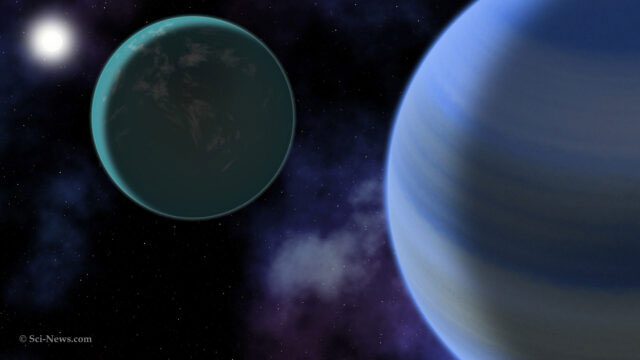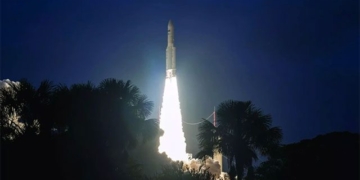Ambiguous Data on Two Massive, Planet-like Moons Sparks Heated Debate in the Scientific Community.
According to Sci-News, a team of scientists led by astrophysicist Rene Heller from the Max Planck Institute for Solar System Research in Germany has attempted to verify a “treasure” within the data legacy of the Kepler Space Telescope: Something that appears to be two gigantic moons.
Although the mission concluded in 2018, the data from NASA’s exoplanet-hunting warrior Kepler continues to astonish as scientists worldwide analyze it together.

Graphic depicting a Jupiter-sized planet with Neptune-sized moons – (Image: SCI-NEWS).
The new discovery arises from what Kepler collected around two Jupiter-like planets named Kepler-1625b and Kepler-1708b.
Some research groups previously detected and measured what they believed to be moons of these planets using a method similar to that employed in the hunt for transiting planets.
These exoplanets and their moons are so far away that they cannot be observed directly.
However, the “light curve” of the parent star—meaning the subtle changes in light data when a planet accidentally transits between it and Earth—provides scientists with enough information to identify and understand that planet.
With the two hypothetical moons orbiting the aforementioned planets, their existence seems to be revealed by a further dimming of the light curve.
Remarkably, calculations suggest that they are significantly larger than Earth, comparable in size to Neptune!
Nevertheless, this finding has sparked intense debate, as the existence of such large moons seems implausible.
“Due to the movement of the moons and planets around the parent star, the additional dimming of the light curve follows a rather complex pattern,” Dr. Heller stated.
Thus, they created simulations of factors that could cause the star’s light curve to “dim twice.” Millions of scenarios were considered, including “eclipses” caused by the moons affecting the planet, as well as the planet affecting its parent star.
Additionally, as we know, many factors can alter a star’s light curve, from cosmic dust clouds to incoming asteroids.
The results were quite “heartbreaking”: The likelihood of Kepler-1708b having a moon significantly decreased; while the dimming of Kepler-1625b could be explained by the darkening of the star’s disk edge due to this planet’s position and size.
Utilizing the Hubble Space Telescope, a “heavyweight” observatory that has been operational for over three decades, scientists found the hypothesis regarding the darkening of the star’s disk to be quite plausible.
However, that remains just a hypothesis.
Thus, while the new discovery leans towards the non-existence of Neptune-sized supermoons, it opens up an intriguing puzzle: What has caused the dimming of these two gigantic exoplanets?
It is likely that this is a type of object or phenomenon that is incomparable to anything else in the Solar System and has yet to be discovered by humanity.




















































